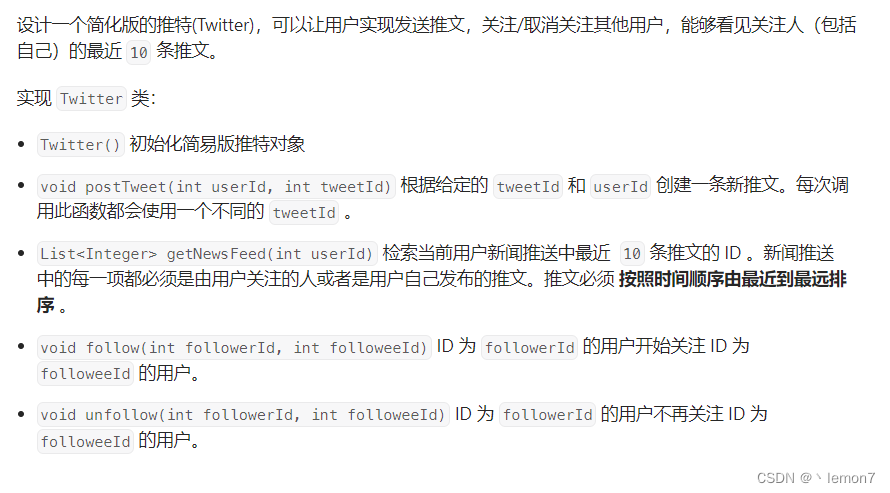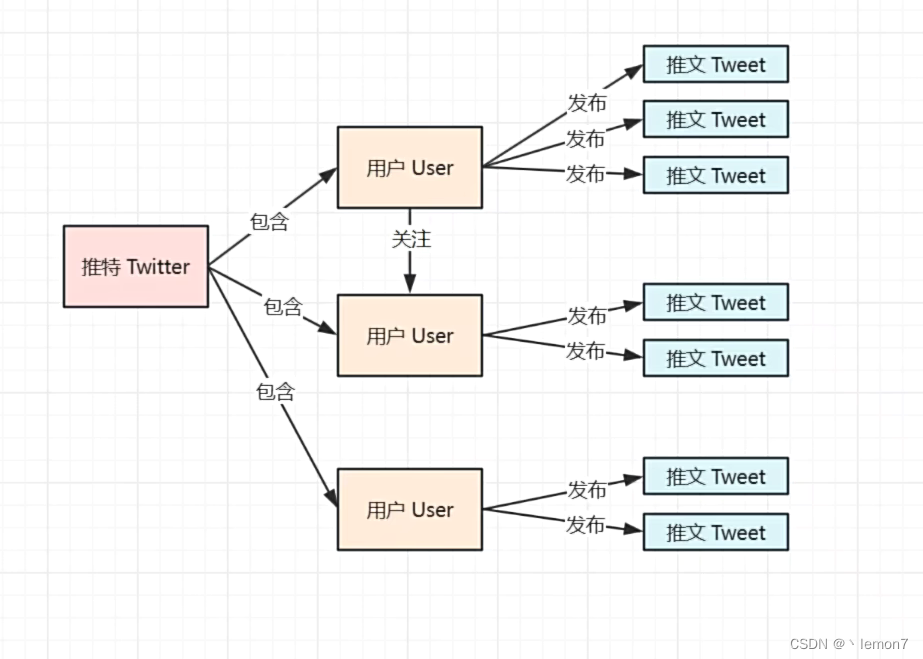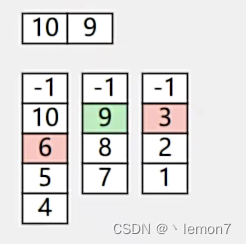例题:

https://leetcode.cn/problems/design-twitter/
分析:
推特其实类似于微博,在微博中可以发送文章。
求解这类题目,我们需要根据题目需求,利用面向对象的思想,先对需求做一个抽象,看看能抽象出哪些对象。可以看出,题目中有3个对象:推特对象、用户对象、文章对象。
下图表示这3类对象之间的关系:

我们知道,一个推特包含多个用户,推特和用户之间是一对多的关系,因此在推特类中可以创建一个map集合来保存用户数据;同样,一个用户可以发送多条文章,用户和文章也是一对多的关系,因为题目有一个方法,获取一个用户发送的近10条文章(其中包括关注者发送的),我们可以用一个链表来存储推文,在用户类中设置一个头节点。
一个用户也可以关注多个用户,用户与用户之间也是一对多的关系,可以用一个set集合存储关注的用户。
这里面有个方法getNewsFeed()获取最新的10篇文章, 包括自己发送的和关注者发送的,其实这就是一个多链表合并问题,按推文时间合并,可以采用大顶堆的方式把自己的推文和关注者的推文加入堆中,然后从堆中弹出一个最近的文章,然后再加入该链表的下一篇推文。


如上图,假设①号链表 表示用户的推文,其它链表是关注者的推文,首先依次把 各链表的头节点加入堆中(10, 9, 3),在堆中弹出一篇最近的文章(10)。紧接着加入被弹出链表的下一个节点(6),再和其它链表头的元素相比选出最近的,依次类推。
代码实现:
package leetcodeup;import java.util.*;public class TwitterLeetcode355 {static class Twitter {public Twitter() {}static class Tweet{int tweetId;int time;Tweet next;public Tweet(int tweetId, int time, Tweet next) {this.tweetId = tweetId;this.time = time;this.next = next;}public int getTweetId() {return tweetId;}public int getTime() {return time;}}static class User{int userId;public User(int userId) {this.userId = userId;}Tweet head = new Tweet(-1, -1, null);Set<Integer> followees = new HashSet<>();}private final Map<Integer, User> userMap = new HashMap<>();private static int time;//发布文章public void postTweet(int userId, int tweetId) {User user = userMap.computeIfAbsent(userId, User::new);user.head.next = new Tweet(tweetId, time++, user.head.next);}//新增关注public void follow(int followerId, int followeeId) {User user = userMap.computeIfAbsent(followerId, User::new);User followee = userMap.computeIfAbsent(followeeId, User::new);user.followees.add(followee.userId);}//取消关注public void unfollow(int followerId, int followeeId) {User user = userMap.get(followerId);if(user != null){user.followees.remove(followeeId);}}//获取最新的10篇文章(包括自己和关注者)public List<Integer> getNewsFeed(int userId) {PriorityQueue<Tweet> queue = new PriorityQueue<>(Comparator.comparingInt(Tweet::getTime).reversed());User user = userMap.get(userId);if(user == null){return List.of();}if(user.head.next != null){queue.offer(user.head.next);}Set<Integer> followees = user.followees;for (Integer id : followees) {User followee = userMap.get(id);if(followee.head.next != null){queue.offer(followee.head.next);}}List<Integer> res = new ArrayList<>();int count = 0;while(!queue.isEmpty() && count < 10){Tweet tweet = queue.poll();res.add(tweet.tweetId);if(tweet.next != null){queue.offer(tweet.next);}count++;}return res;}}
}

--Manacher(马拉车)算法)
——通过重构找到深层次模型2)
![vim恢复.swp [BJDCTF2020]Cookie is so stable1](http://pic.xiahunao.cn/vim恢复.swp [BJDCTF2020]Cookie is so stable1)

)
:使用自然语言处理技术提升证券投资决策效率)

![[ffmpeg] 获取编译配置信息](http://pic.xiahunao.cn/[ffmpeg] 获取编译配置信息)
性能对比(提供MATLAB代码))



![[VNCTF2024]-Web:CheckIn解析](http://pic.xiahunao.cn/[VNCTF2024]-Web:CheckIn解析)
)
第一个练习所编写的函数打印一个istringstream对象的内容。)



